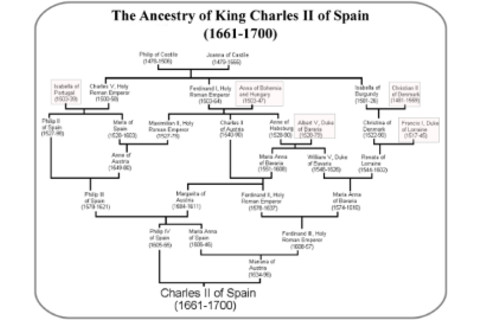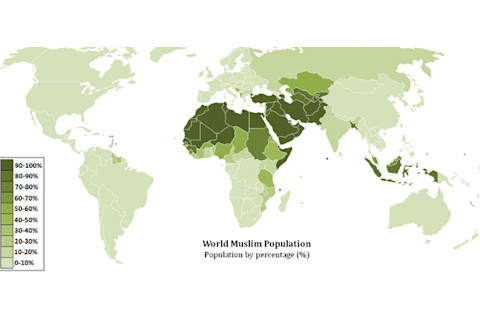The map above shows the distribution of consanguineous marriages. As you can see there’s a fair amount of cross-cultural variation. In the United States there’s a stereotype of cousin marriage being the practice of backward hillbillies or royalty. For typical middle class folk it’s relatively taboo, with different legal regimes by state. The history of cousin marriage in the West has been one of ups & downs. Marriage between close relatives was not unknown in antiquity. The pagan emperor Claudius married his niece Agrippina the Younger, while the Christian emperor Heraclius married his niece Martina. Marriage between cousins were presumably more common. With the rise in the West of the Roman Catholic Church marriages between cousins were officially more constrained. Adam Bellow argues in In Praise of Nepotism: A Natural History that there’s a material explanation for this: the Roman church used its power over the sacrament of marriage to control the aristocracy. Though the church required dispensations for marriages between cousins of even distant degrees of separation, they were routinely given, as was obviously the case among Roman Catholic royal families like the Hapsburgs. But once given the dispensation could be revoked, rendering the marriage null and void. A highly convenient power politically.

But for much of European history the marriages of common folk were not of much concern to the church. Using ecclesiastical records L. L. Cavalli-Sforza documents very high levels of cousin marriage in Italy in the 19th century in Consanguinity, Inbreeding, and Genetic Drift in Italy. The rates dropped rapidly with economic development, especially better transportation networks in mountainous regions. I think this explains the patterns in the United States, extremely isolated communities are more inbred, while most Americans have traditionally been very mobile and not relied excessively on family networks. In northern Europe cousin marriage was not unknown in the 19th century, Charles Darwin famously married his cousin. With the Reformation official church sanctions against cousin marriage on the aristocracy and gentry were relaxed, and a few clusters of closely networked intermarried clans arose, such as the Darwin-Wedgewood family (the Catholic Church had also been a bulwark against forced marriages of aristocratic women, who always had life in a religious order as a possibility. The Reformation in Germany seems to have initially resulted in a sharp increase in the power of the patriarch over the marital fates of his daughters because of the removal of the religious safety valve as leverage). I think that the case of Charles Darwin and his social set speak to the attraction of cousin marriage: familiarity breeds affinity. In Victorian England a small group of closely related and affiliated elite gentry families, the Darwins, Keynes, Wedgewoods, Galtons, etc., created a subculture which spawned subsets such as the Bloomsbury Group.
With a more fluid and harshly meritocratic global elite the attraction of cousin marriage seems to have diminished in the Western world. Consider the tycoon Rupert Murdoch. He is an American citizen born in Australia married to a Cantonese woman with grandchildren who are 1/4 Ghanaian, 1/4 Dutch, 1/4 ethnic Scotch (Australian) & 1/4 ethnic Estonian (Australian) . As for the common people, geographical and social isolation is sharply mitigated by modern transportation networks, as well as larger scale non-kin institutions such as the Christian church. The same dynamics do not necessarily apply outside of the developed world. A friend whose father is Arab once explained that cousin marriage was so pervasive in that culture in part because you marry who you meet, and it is difficult in Arab societies for men to meet women who were not their cousins. In less individualistic societies where zero sum power dynamics are still operative it may also be beneficial for a wife to be related to the family into which she is marrying. Anthropologists in South Asia attribute the more equitable power dynamics between the genders in Hindu South India as opposed to more patriarchal Hindu North India to the fact that in the South cousin (and uncle-niece) marriage is practiced, while in the north exogamy is the norm. In the latter case a young woman leaves her family and becomes a “stranger” in her husband’s home. In the former case one of the new in-laws is a blood aunt or uncle.
But that’s the cultural anthropology. What may be fit for a cultural kin-unit may not be biological fit for individual lineages. What are the risks of cousin marriage? Most obviously there are recessive diseases. Those illnesses which are expressed when you carry two malfunctional copies of a gene. Cystic fibrosis, tay sachs, various forms of deafness. Why is it that cousins have a higher risk of this occurring? Because two cousins are much more likely than two random individuals to share the same distinct gene from a common ancestor, because their common ancestors are so much more recent. More precisely the coefficient of kinship between two first cousins is 1/8. That means that at any given locus there’s a 1 out of 8 chance that the two individuals will have alleles which are identical by descent, which means that the genetic variant comes down from the same person in the family line.
If the allele is “good,” that is, totally normal/wild type, not associated with any pathology, then we’re in the clear. That’s why most first cousin marriages don’t produce children who are monsters. What a first cousin marriage does is change the odds. How you present these odds matters a great deal in how scary they sound. If I told you than the chance of first cousins having children with a birth defect is 4-7%, vs. 3-4% for a non-consanguineous couple, it might not sound that bad. But if I told you that the odds of having a birth defect is ~50% greater, then it sounds worse. Additionally, the costs of congenital illness are born by the offspring, and society through health insurance premiums. If you compared a society which had a tradition of universal first cousin marriages vs. one which didn’t, you’d see 50% more birth defects in the former society in the aggregate, all things equal.
But that’s the not the only issue there. There are two opposing forces which diminish the problems of common cousin marriage and make it worst. The first is the purging of genetic load which occurs when you expose deleterious recessive alleles. Remember that low frequency recessively expressed alleles aren’t exposed to natural selection because they’re mostly found in heterozygotes. This means they get to float around in the gene pool for very long periods of time. In plant breeding you can just “self” the plants, which will expose the alleles rather quickly, since selfing is an extreme form of inbreeding, purging heterozygosity. The deleterious alleles then are removed from the gene pool through the death of individuals who carry them in homozygote state. The theory is that some human populations which practice cousin marriage at higher frequencies may have a lower frequency of deleterious recessive alleles. Alan Templeton reports this for South Indian Hindus in Population Genetics and Microevolutionary Theory, and L. L. Cavalli-Sforza does the same for the Japanese in the aforementioned monograph. In the proximate sense this purging of the genetic load occurs through human misery. The early death of individuals, or their sterility, or sharply reduced fertility because of illness. In the ultimate sense it’s somewhat speculative, and many geneticists are skeptical that complex mammals are easy to analogize with plants which do occasionally self in the wild.

That’s the positive genetically. What’s the negative? Pedigree collapse. I’ve been talking about marriages between first cousins throughout this post, but that’s really a small issue next to this. Even first cousin marriages produce individuals with a fair amount of inbreeding. I ran a test for runs of homozygosity in my 23andMe genetic profile and I got 3 hits, while a friend whose parents are first cousins got ~70 (the parameters for the test aren’t important, just giving a relative sense). For inbred clans it gets much worse because people are related in many different ways, and genetically are far closer than first cousins. That is what happened to the Spanish Hapsburgs. As you can see from the pedigree of Charles II his parents were closer than typical first cousins. The Samaritans of Israel are a religious sect which seems to be going through pedigree collapse. Some of them are proactively marrying outsiders to prevent their extinction through high infant mortality rates. Others, “traditionalists,” oppose exogamy because intermarriage within the group is the custom, and diseases are God’s will.

The Samaritans are an extreme case. But we may be seeing a thousand Samaritan flowers blooming across the Middle East. From what I know cousin marriage in the Middle East is not limited to Muslims, Christians and Jews practice it as well. But among many Muslims it has some cachet because of particular hadiths which point to this practice as preferred. Setting religion aside, there are also social reasons why this practice is common. As I noted above sex segregation means that you may not know women outside of your family well, and in some societies where veiling is practiced it may be that you do not see many women you are not related to (even if veiling occurs at puberty, you may have seen your cousin at a younger age). Marriages are bonds which may tie a family into one operational social unit, and so produce a powerful inbred clan. This illustrates the cross-purposes of a cultural unit of selection vs. the individual unit of selection. In a society where clan vs. clan competitions are critical sorting mechanisms consanguineous marriages may serve as beneficial cross-linkages. Balanced against this of course are marriages across clans. On an individual level a first cousin marriage reduces the reproductive fitness, but higher potential reproductive fitness of two individuals who have no social support because of ostracism may be a moot point.
From my cursory reading of the literature consanguineous marriage is not declining in much of the Muslim, especially Arab, world. Why? I can think of two superficial reasons obvious to someone like me, who is no anthropologist or sociologist with area knowledge. First, high fertility rates and lower infant mortality means that the sample space of possible matches increases. One way you can remove the option of cousin marriage is by shrinking the pool of potential cousins you may marry. In a Malthusian world the average family has only two children who manage to survive to adulthood and reproduce. The variance around this expectation means that many families will disappear within two or three generations simply due to stochastic forces. This is why Augustus attempted to use moral suasion and coercion to have the Roman Senatorial class reproduce at a higher rate. The aristocracy was going extinct as clans which were defined by a legitimate male line succession would routinely have a generation without a male heir (this explains the popularity of adoption in Roman society, with adoptees often being younger sons of related lineages). Later in imperial history Marcus Aurelius and his maternal cousin, Faustina the Younger, had thirteen children, but only four survived to adulthood. The modern world is very different, and great clans can rise in just a few generations if one has the will. A second reason I believe that cousin marriage is popular in the Arab world is economics. Specifically, commodity/resource driven economic growth doesn’t require great median human capital investment, so there isn’t an incentive to shift toward a less familial social structure. In plain English going to university, moving regularly for your career, etc., are going to weaken the bonds of affinity you may have with your family. This is not necessary for many Gulf Arabs, who have a guaranteed a minimum income because of resource revenue. Not only has this allowed them to preserve a relatively archaic set of social norms, but I believe it’s also allowed for the baroque elaboration of their customary traditions. I don’t find the second explanation persuasive for most Muslim nations though, as they aren’t as reliant on resource driven revenue, and have had to make more accommodations with the exigencies of the modern world. I believe that in all likelihood large families are probably responsible for the resurgence or persistence of the practice in societies where it has been the preferred pairing.

inbreeding
This post was inspired by a recent Channel 4 special, When Cousins Marry: Reporter Feature. If you live in Britain you can probably watch it online (I can not). But it highlights that the issue is going to be salient in the United Kingdom for a generation or so at a minimum. As I said, in the United States inbreeding is a way to make fun of poor, uneducated, and isolated whites. The photo to the right is from a blog entry mocking anti-Obama activists who were protesting his address to the children of the nation as “racist, inbred hicks.” The American perception of inbred people is not particularly positive, and the accusations of being inbred are used to mock and humiliate. But when it comes to the issue in Britain it is different, because consanguineous marriage is a feature of the Muslim community, and there are issues of race, religion and class which are operative. It isn’t just custom and tradition which are driving people to marry their cousins in Britain (perhaps more accurately, parents are demanding their children marry their cousins). Marrying one’s cousin is a rather convenient way in which to allow more of your relatives to immigrate. In a subculture where arranged marriage is the norm the marrying a cousin abroad seems eminently rational for the clan’s prospects. But there are other forces at work in the community which perpetuate and encourage it as well, and those forces can not be frankly addressed because of the tensions which are normal in many multicultural societies. From the summary of the program:
‘An attack on Pakistani culture’
However I also spoke to some people in cousin marriages who felt there were great benefits and questioned if it was yet another aspect of their culture that was coming under attack.
This sentiment has been echoed several times during the making of this Dispatches programme. It’s a subject that has provoked a defensive and sometimes hostile reaction every time we’ve touched upon it. We spoke to dozens of families who refused to talk about it on camera and we were told frequently that even to discuss the issue was an attack on Pakistani culture or worse still, Islam.
Since Britain has the NHS this is a going to be a major public health issue. On the one hand, there is individual freedom of choice. This is a core Western value. On the other hand, there is the fact that health care costs are a long term structural issue for the fiscal health of any society. Ethnic Pakistanis are only a few percent of Britain’s population, so it is manageable right now, but their proportion will slowly rise because of higher fertility and continued immigration. If cousin marriage continues to remain popular in the community the later generations are going to have even greater health problems because of higher inbreeding coefficients (due to repeated cousin marriages across the generations within the family).
But why should we limited these sorts of social utilitarian considerations to cousin marriage? How about the increased debilities associated with the children of older mothers? Mothers who make recourse to assisted reproductive technology such as in vitro fertilization? Lines have to be drawn. Costs and benefits have to be evaluated. With the passage of health care reform in the United States in 2010 the issue is now explicitly socialized in all developed nations. I began the post with a social-cultural narrative, and I end it with a reiteration of the importance of a social-cultural context.

Image Credits: Wikimedia, Consang.net, youoffendmeyouoffendmyfamily














